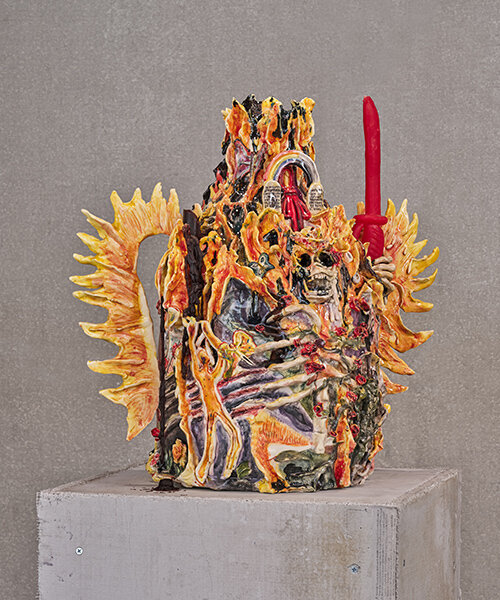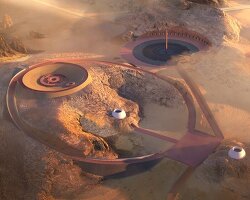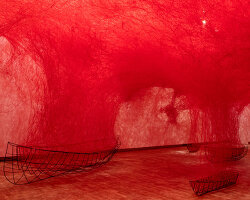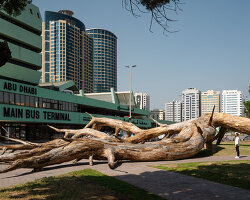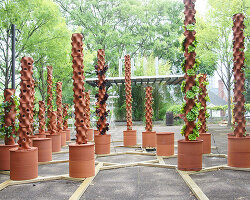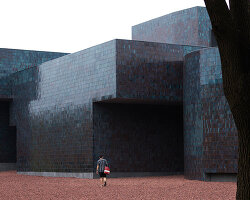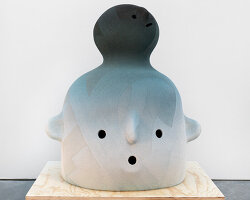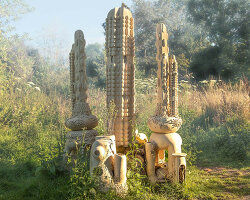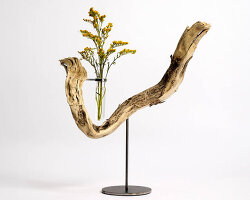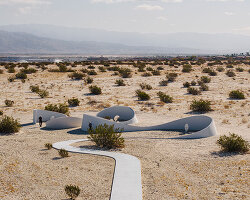sculptural works of concrete, sand & ceramics
Guadalajara-based artist Alejandro García Contreras brings his signature blend of ceramics, concrete, and video installations to Brooklyn with his first institutional solo exhibition, ¿Quien no ha intentado convertir una piedra en un recuerdo? (Who hasn’t tried to turn a stone into a memory?) at Pioneer Works. This ambitious show channels the spirit of an archaeological site left behind by an ancient, unknown civilization. Combining intricate craftsmanship with conceptual depth, the artist challenges visitors to ponder the relationship between objects, memory, and mortality. ‘Trying to create a mark of existence or proof of our transient state on Earth is one of humanity’s greatest obsessions,’ he tells designboom in an interview.
The exhibition is rooted in an interplay between permanence and impermanence, contrasting ancient cultural relics with modern materials and practices. Sand, a recurring material in Contreras’s work, becomes a powerful metaphor for transformation, as he explains: ‘The hardest rock turns to dust… our bodies disintegrate into dust, becoming part of the cycle of life.’ These ephemeral symbols, arranged within mounds of sand, evoke a desolate desert landscape, accentuated by dead plants, skeletal remains, and sculptural concrete pillars cast during Contreras’s residency at Pioneer Works. Visitors are reminded of humanity’s attempt to immortalize itself through material and memory. ¿Quien no ha intentado convertir una piedra en un recuerdo? (Who hasn’t tried to turn a stone into a memory?) is on view at Pioneer Works in Brooklyn between September 6th — December 15th, 2024.
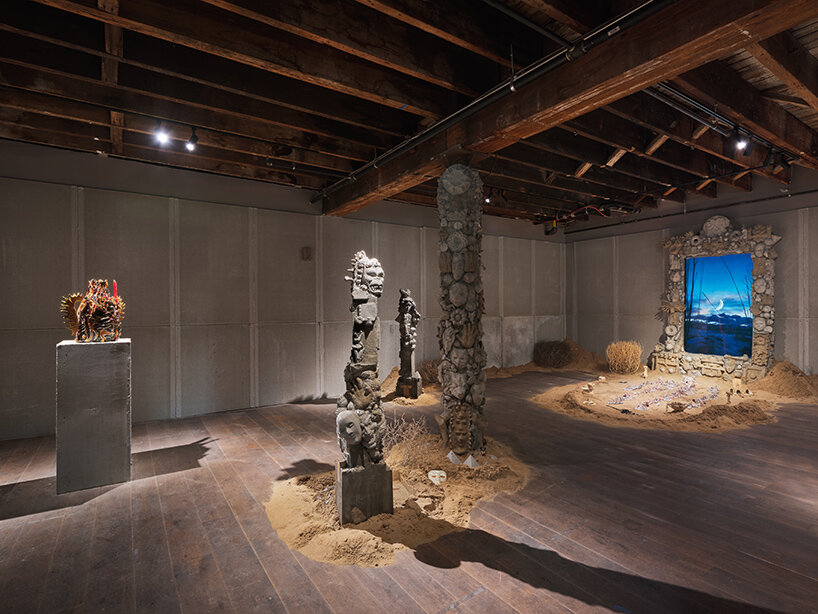
installation view of Alejandro García Contreras: ¿Quién no ha intentado convertir una piedra en un recuerdo? at Pioneer Works, September 6 — December 15, 2024. courtesy of Pioneer Works. photo by Olympia Shannon
mythical themes on view at pioneer works
Alejandro García Contreras draws from a vast range of influences, from ancient pagan civilizations and pre-Hispanic Mexican culture to the writings of Alan Watts and the imagery of childhood cartoons like Sailor Moon and Thundercats. The artist sees these disparate references as part of an interconnected language. ‘Alan Watts brings us closer to understanding life as transient,’ he explains, ‘while Thundercats and Sailor Moon reinterpret ancient myths through futuristic lenses.’ These references amplify the exhibition’s dual focus on personal and collective memory, bridging the ancient with the contemporary and the mythical with the tangible.
The exhibition is tied to Contreras’s residency at Pioneer Works, where he had the resources and space to push the boundaries of his practice. Reflecting on the process, Contreras says, ‘Each project and residency brings different perspectives to my practice, and it is wonderful to feel how each place leaves a mark on our language and memory.‘ The resulting installation, at once monumental and intimate, invites visitors to explore the fragile yet enduring traces of human existence. Contreras’s innovative use of materials and storytelling cements his position as a vital voice in contemporary art, transforming Pioneer Works into a reflective space where past and present collide. Read the full interview with Ajelandro Garcías Contreras below!
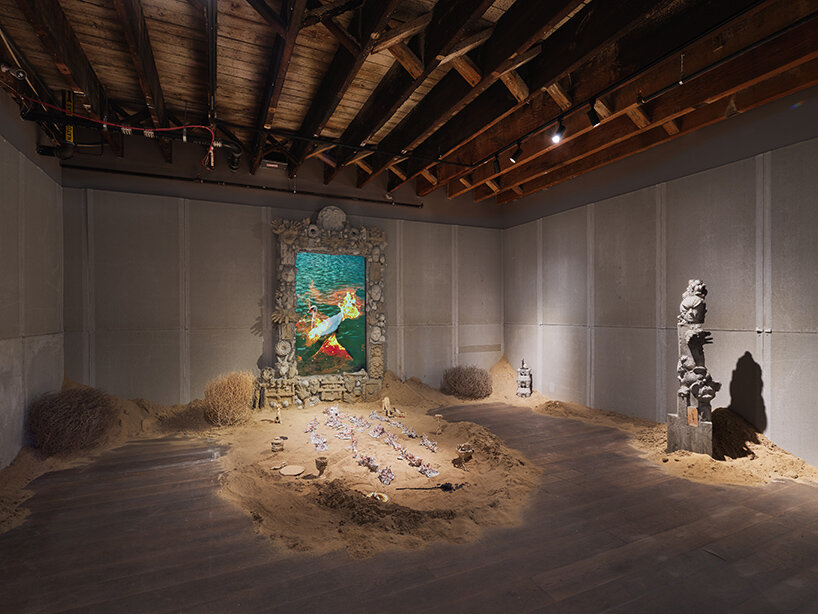
installation view of Alejandro García Contreras: ¿Quién no ha intentado convertir una piedra en un recuerdo? at Pioneer Works, September 6 — December 15, 2024. courtesy of Pioneer Works. photo by Olympia Shannon
Dialogue with alejandro garcía contreras
designboom (DB): The title of the exhibition suggests a universal longing to preserve memory. Can you share how this idea developed and what inspired you to frame your work within this question?
Alejandro García Contreras (AGC): Perhaps the differentiation between humans and other species lies in our rational capacity to understand or interpret our existence. I have always felt a fascination for ancient cultures. The fact that all human empires are destined to disappear seems paradoxical and intriguing to me. Trying to create a mark of existence or proof of our transient state on Earth is one of humanity’s greatest obsessions. From the first petroglyphs and cave paintings to the construction of cities, temples, writing books, or creating sculptures, it seems that humanity’s main fixation is to endure over time and to create a memory in the collective consciousness. Whether this is worthwhile or not is another story, but for me, it is a constant question. Does memory persist? Or is it just an interpretation of my existence? Ultimately, what is curious is that over time, many of these meanings or facts are lost, leaving behind mysterious objects and cities that are often reinterpreted. So what truly endures?
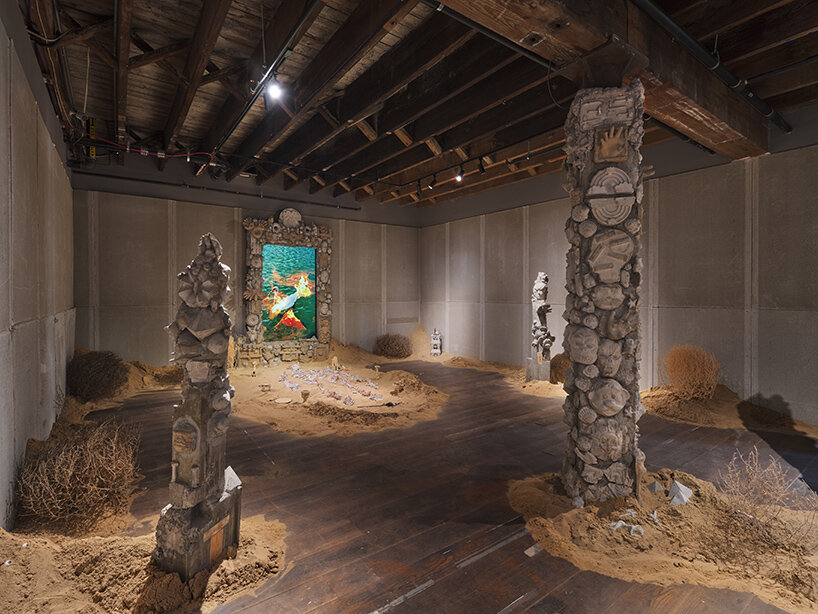
installation view of Alejandro García Contreras: ¿Quién no ha intentado convertir una piedra en un recuerdo? at Pioneer Works, September 6 — December 15, 2024. courtesy of Pioneer Works. photo by Olympia Shannon
DB: Your work combines ceramics, concrete, and various organic materials like sand and plants. How do these materials contribute to your exploration of memory, mortality, and transformation?
AGC: The relationship between ceramics and the history of humanity is very strong. Ceramics are an element present in every civilization that has ever existed and has left its mark on the planet. Concrete was of great importance to Roman architecture, and in modern times, its use has spread, becoming a representative material of contemporary culture. Today, it is almost impossible to think of cities and construction without the use of concrete. Both materials are very representative of our obsession with permanence and the construction of memory. Mortality is symbolically represented by certain elements such as dead plants, sand, bone remains, and the concept of ruins. Sand is also an element that represents transformation; the hardest rock turns to dust, cities disappear, and our bodies disintegrate into dust, becoming part of the cycle of life, returning to the earth. Each element and material in this exhibition has a symbolic function and represents connections of different meanings among them.
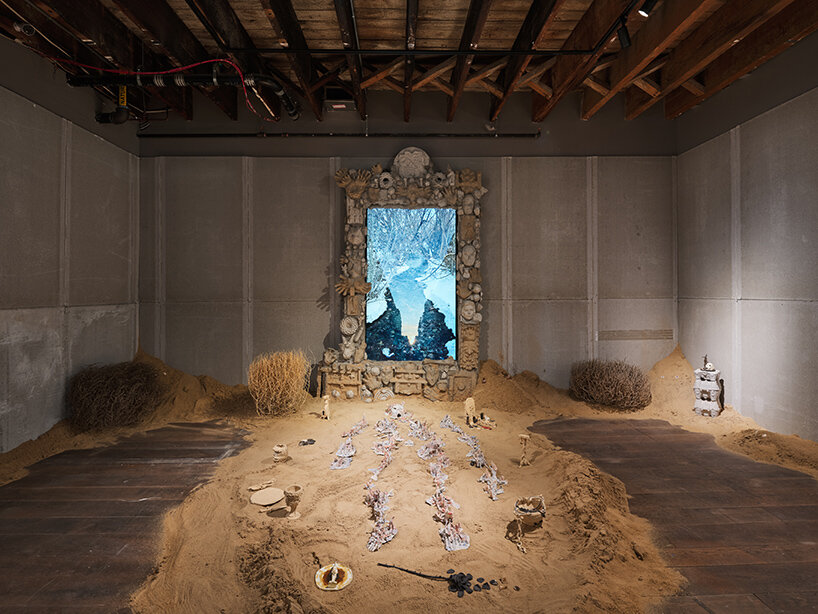
installation view of Alejandro García Contreras: ¿Quién no ha intentado convertir una piedra en un recuerdo? at Pioneer Works, September 6 — December 15, 2024. courtesy of Pioneer Works. photo by Olympia Shannon
DB: In this exhibition, you draw on an ‘archeological site’ concept, blending references to ancient civilizations with modern elements. What sparked your interest in this fusion, and how does it reflect your vision of the past and present?
AGC: Since I was a child, I grew up with the myth of the great post-apocalyptic catastrophe. On Sundays, I would often wake up in the morning and watch movies like Mad Max, Planet of the Apes, or Terminator on open television. This definitely had a significant influence on me. Another constant memory is visiting archaeological sites in Chiapas (where I was born and raised) with my parents. We would visit the site of Palenque, where I often remember going down to see the crypt of King Pakal’s tomb inside the famous Temple of the Inscriptions. I believe this entire imagery nurtured a language that has been developing since my childhood.
The concept of the great human catastrophe is a constant in our day-to-day lives, whether it be due to wars, the misuse of nuclear weapons, threats from artificial intelligence, or environmental catastrophes; the possibility of living on the edge of collapse, in a pre-apocalypse, is more present than ever. So, what will remain of us? In some way, and out of an obsession with permanence, this may be one of the main reasons I am interested in ceramics, as this material is a great survivor and narrator of past myths. On the other hand, and in a way closer to currents like symbolism or romanticism, I am interested in creating these landscapes where the remnants of contemporary culture survive as ruins.
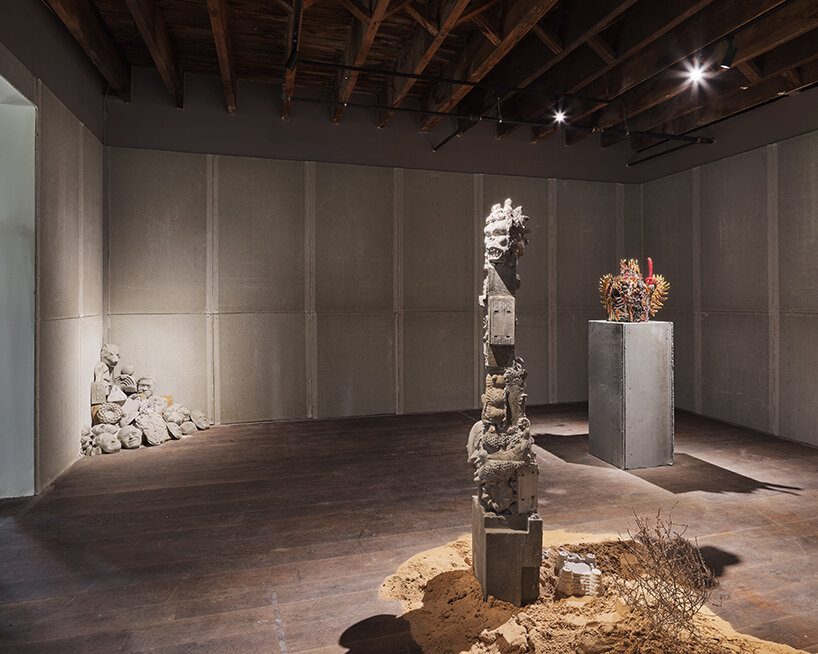
installation view of Alejandro García Contreras: ¿Quién no ha intentado convertir una piedra en un recuerdo? at Pioneer Works, September 6 — December 15, 2024. courtesy of Pioneer Works. photo by Olympia Shannon
DB: A porcelain skeleton is said to ‘witness the passage of time.’ What role does this figure play in your larger narrative about life, death, and memory?
AGC: The skeleton is a remnant of the presence of death. Throughout my career as a visual artist, the representation and concept of death have had a constant presence in my work. Perhaps it is due to the natural connection we have with death in Mexico, and the constant representation of the skeleton in pre-Hispanic cultures. The fossilization of bones has also allowed us to learn about species that lived in the past and are now extinct, such as dinosaurs. The skeleton serves as a symbol of death and transition, but also as proof of memory and existence. Of reality and mystery. Death remains the only end we humans have in common, and yet we still do not know what to expect from it. It is like a perfect playground for imagination. I suppose that is why so many human cultures have their own interpretations of it and of life after death.
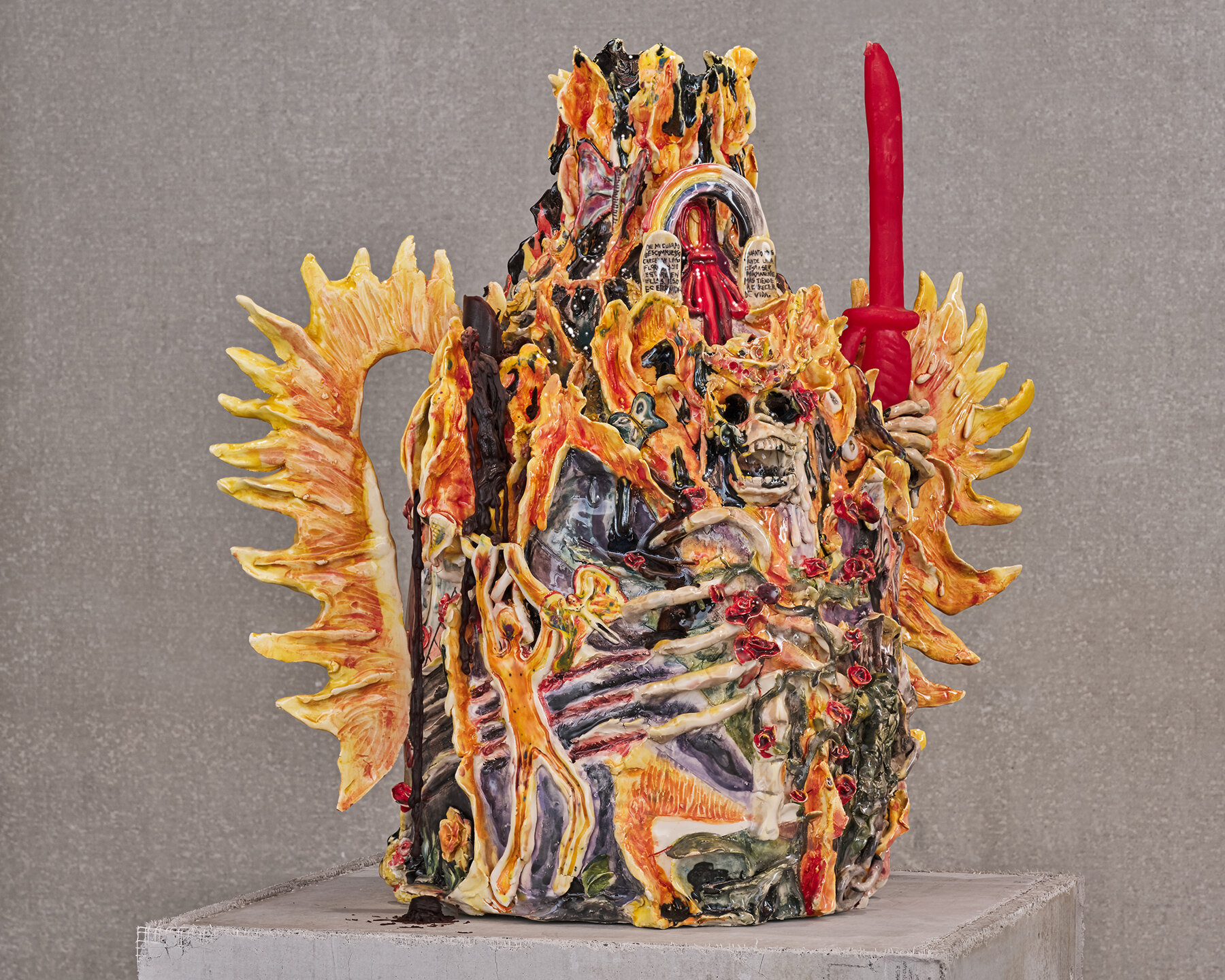
installation view of Alejandro García Contreras: ¿Quién no ha intentado convertir una piedra en un recuerdo? at Pioneer Works, September 6 — December 15, 2024. courtesy of Pioneer Works. photo by Olympia Shannon
DB: You’ve referenced influences like Le Palais Idéal and the Temple of the Inscriptions. How have these architectural sites shaped your perspective on monumentality, remembrance, and the idea of a personal legacy?
AGC: Both the Ideal Palace of Cheval and the Temple of the Inscriptions are constructions whose function was to serve as a tomb. It seems to be a constant obsession for humans to generate monuments for themselves, an irrefutable proof and remembrance of their passage through existence. The monument is not just a physical object, but also the constancy and determination of a single task. The artist’s habit is very similar; constant determination and commitment to a way of perceiving the world is the main pillar of exploring creativity.
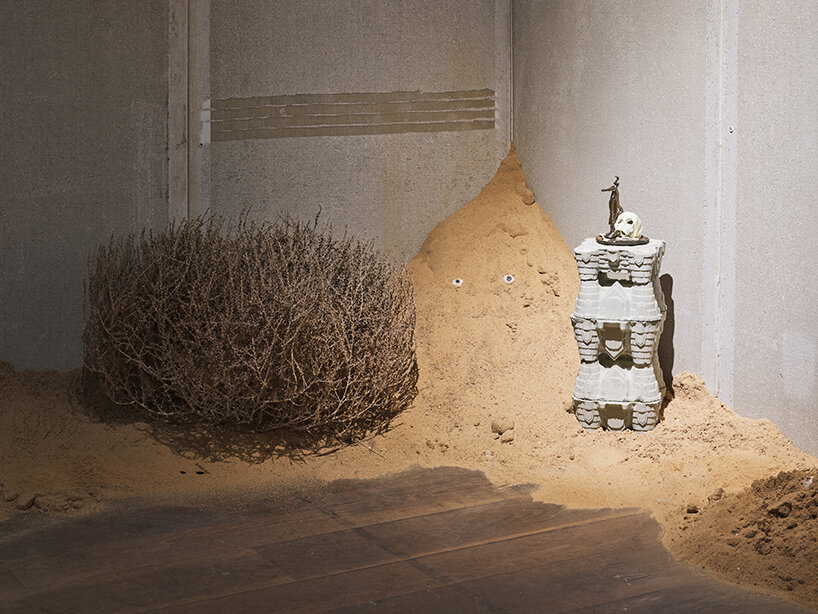
installation view of Alejandro García Contreras: ¿Quién no ha intentado convertir una piedra en un recuerdo? at Pioneer Works, September 6 — December 15, 2024. courtesy of Pioneer Works. photo by Olympia Shannon
DB: How have Jungian archetypes and philosophers like Alan Watts and Joseph Campbell influenced your creative process and the themes? What about the television series Thundercats and Sailor Moon?
AGC: Many of the references in my work come from elements of popular culture. Whether they are religious, mystical, esoteric, or consumer concepts, all these symbols are part of an intricately woven language that Jung refers to as our collective unconscious, and Campbell provides an excellent mapping of the relationship of these archetypes through the analysis of folklore in different cultures and myths. Alan Watts’s philosophy brings us closer to an understanding of life and its changes as transient and uncontrollable situations.
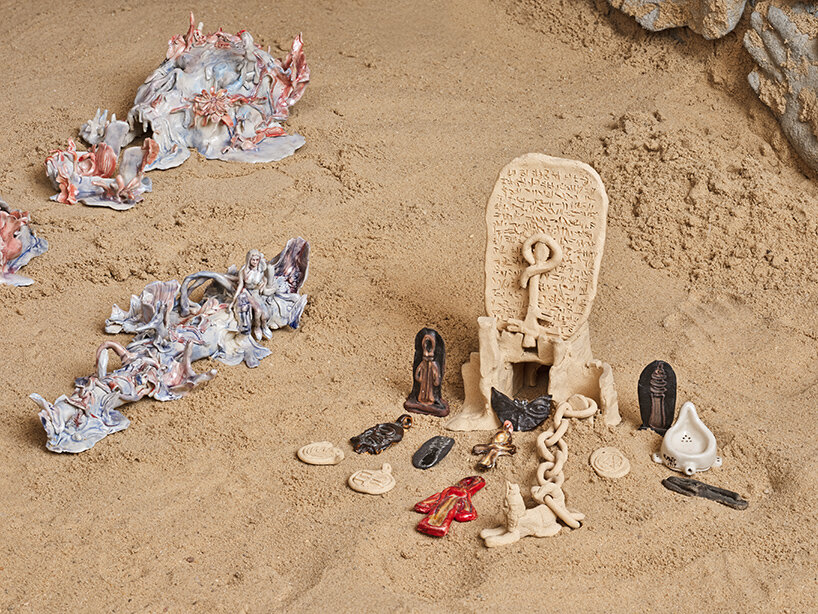
installation view of Alejandro García Contreras: ¿Quién no ha intentado convertir una piedra en un recuerdo? at Pioneer Works, September 6 — December 15, 2024. courtesy of Pioneer Works. photo by Olympia Shannon
AGC continued: Speaking of animated series like Sailor Moon or The Thundercats, in Sailor Moon we find a reinterpretation of Roman myths and the solar system. Male gods are portrayed by women with magical and paranormal powers. We can find references to ancestral female archetypes, such as the worship of the moon, which is basically the foundation of the series. I remember watching The Thundercats and thinking of them as an extraterrestrial race with advanced technology, the forerunners of humanity, yet with a solid spiritual base connected to deep ancestral traditions.
The series is filled with archetypes, symbols, and diverse rituals. One of my favorite elements is the Sword of Prophecies, an intriguing magical sword that serves to access visions of dangers and future possibilities, preventing and saving friends as a result. The main axis of all these myths tends to be universal in nature, and I love being able to find elements that connect them.
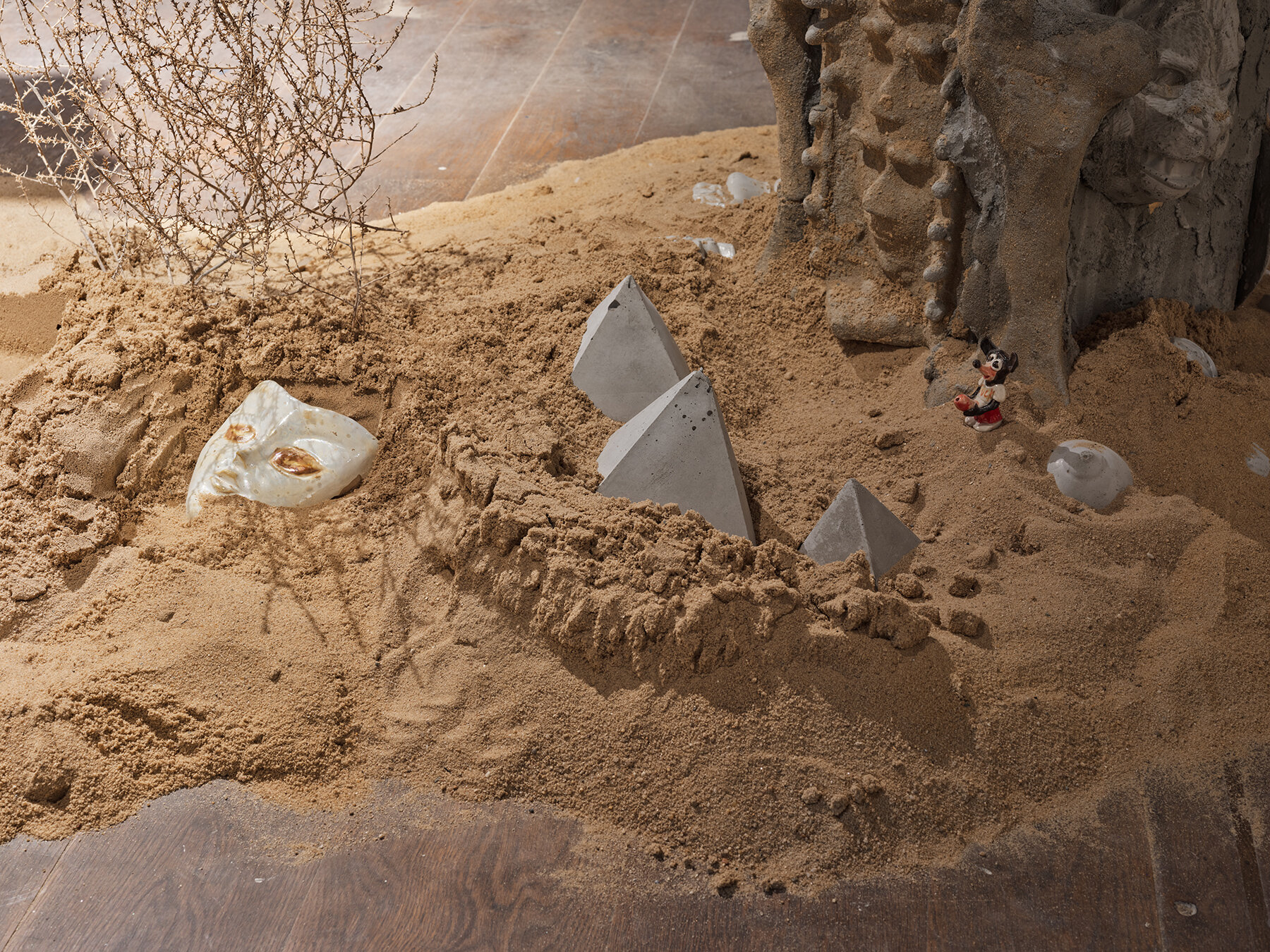
installation view of Alejandro García Contreras: ¿Quién no ha intentado convertir una piedra en un recuerdo? at Pioneer Works, September 6 — December 15, 2024. courtesy of Pioneer Works. photo by Olympia Shannon
DB: The exhibition has a tactile quality, with elements like concrete pillars and sand mounds. What do you hope visitors will feel as they interact with these materials?
AGC: Solid concrete and sand, curiously, seek to create a metaphor for the permanence of things. Every rock, structure, and mountain disintegrates and turns to dust and sand. At the same time, you need sand and certain types of powders to construct a concrete structure. In sand and earth, we also find the materials to make ceramics. Crystals and clays, various powders. All materials connect in some way. I am interested in giving it the character of an existential desert, the ruins of something that existed and that will no longer be. And for a brief moment in time, it can tell its own story.

installation view of Alejandro García Contreras: ¿Quién no ha intentado convertir una piedra en un recuerdo? at Pioneer Works, September 6 — December 15, 2024. courtesy of Pioneer Works. photo by Olympia Shannon
DB: As this is your first institutional solo exhibition, how has your experience and residency at Pioneer Works influenced your perspective or approach as an artist? Have new ideas or directions emerged for you as a result?
AGC: I genuinely believe that it would have been impossible to carry out this exhibition in any other space. The trust that Gabriel Florenz and the Pioneer team had in my project was a driving force for me to push the limits of installation time, production, and access to materials to the fullest extent of my language. I remember nights when my hands would throb with pain from the corrosive nature of cement on my skin. This is not a complaint; I simply recognize my limits.
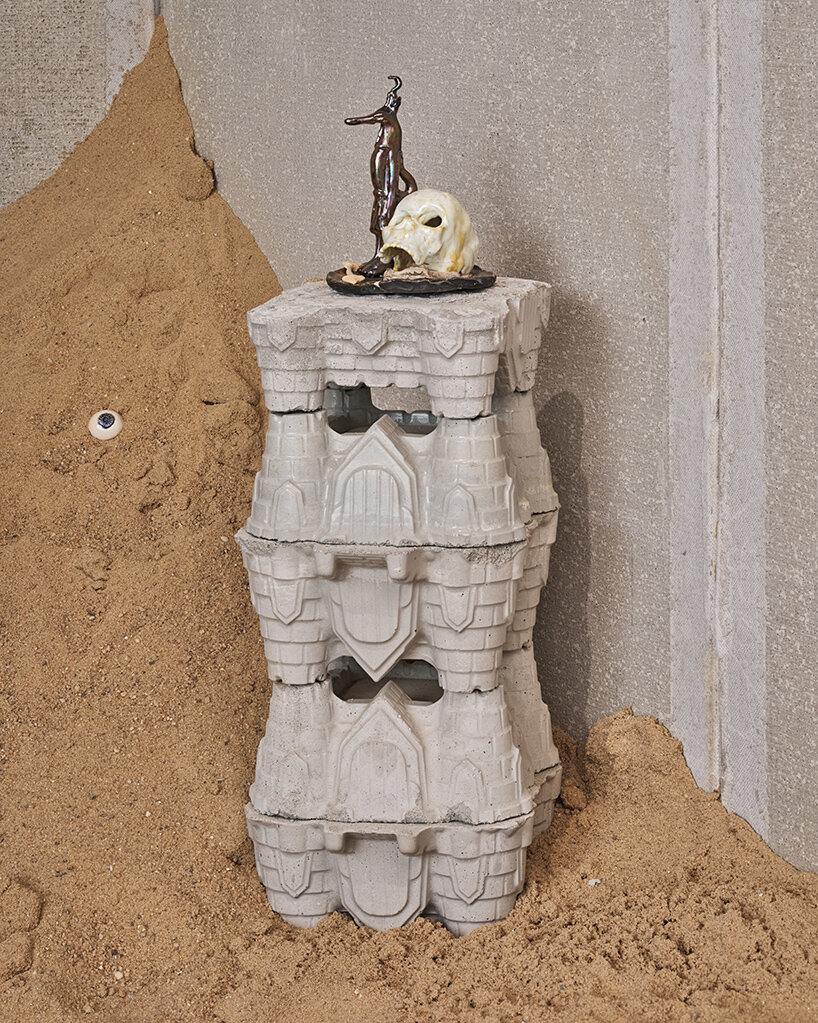
installation view of Alejandro García Contreras: ¿Quién no ha intentado convertir una piedra en un recuerdo? at Pioneer Works, September 6 — December 15, 2024. courtesy of Pioneer Works. photo by Olympia Shannon
AGC continued: Working in my studio until late at night and watching how each piece slowly began to fall into place was exciting and very revealing. We had a certain idea of what we wanted to do, but not how it would ultimately look. Seeing the exhibition finally set up was a beautiful surprise. Each project, each space, and residency brings different perspectives to my practice, and it is wonderful to feel how each place leaves a mark on our language and memory. I feel infinitely grateful to Pioneer Works for all this trust and support.
‘The mystery of death and the mind’s requirement to come to terms with it have been everywhere. The prime inspiration of spiritual inquiry and practice, from the period already of Neanderthal man, over a hundred thousand years ago, when the earliest human burials appear, in graves furnished with provisions for some kind of continuing invisible existence‘ — Joseph Campbell
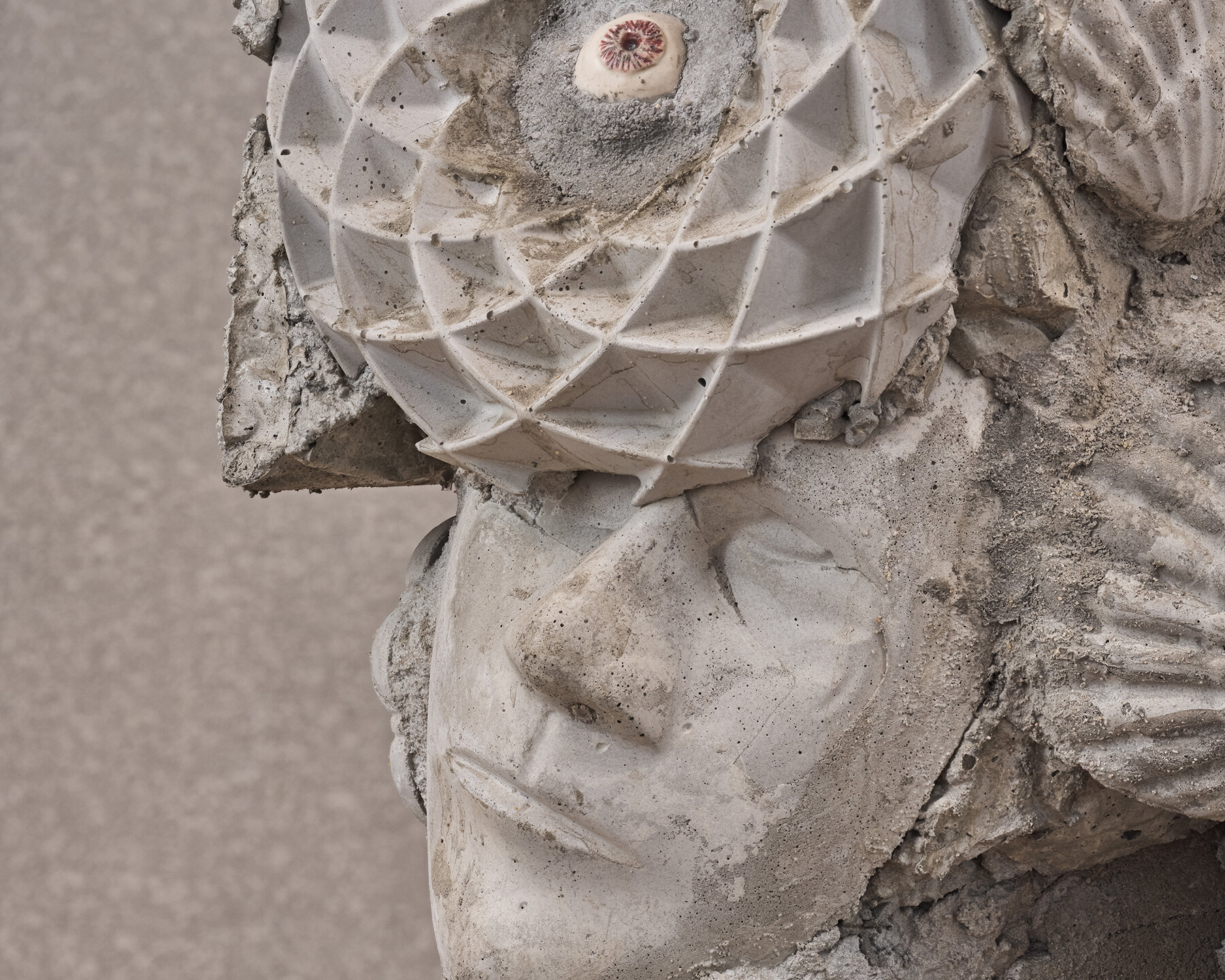
installation view of Alejandro García Contreras: ¿Quién no ha intentado convertir una piedra en un recuerdo? at Pioneer Works, September 6 — December 15, 2024. courtesy of Pioneer Works. photo by Olympia Shannon
project info:
exhibition title: ¿Quien no ha intentado convertir una piedra en un recuerdo? (Who hasn’t tried to turn a stone into a memory?)
artist: Alejandro Garcías Contreras | @alejandrogarciacontreras
gallery: Pioneer Works | @pioneerworks
location: 159 Pioneer St, Brooklyn, NY
on view: September 6th — December 15th, 2024
photography: © Olympia Shannon | @olyshannon
